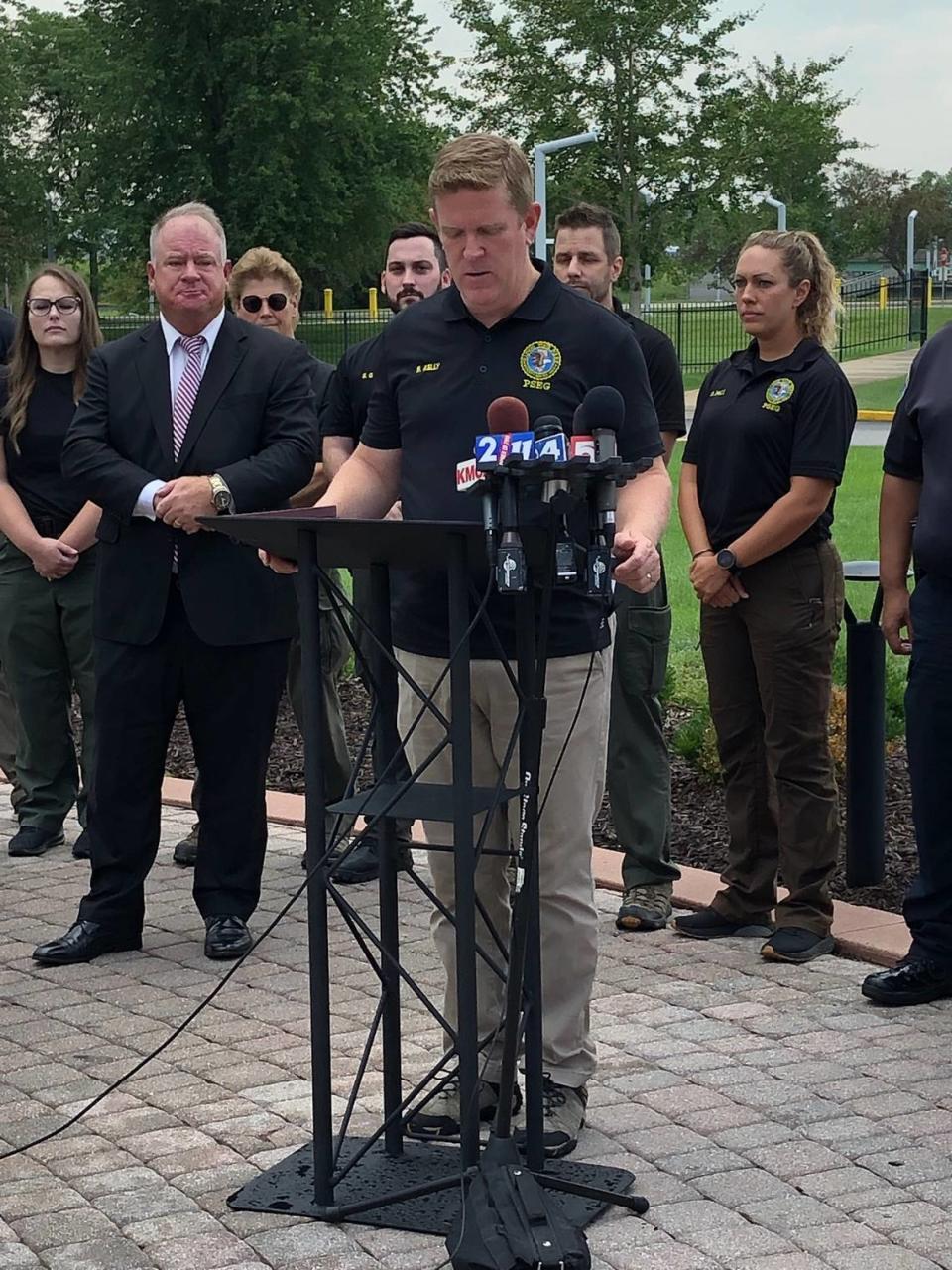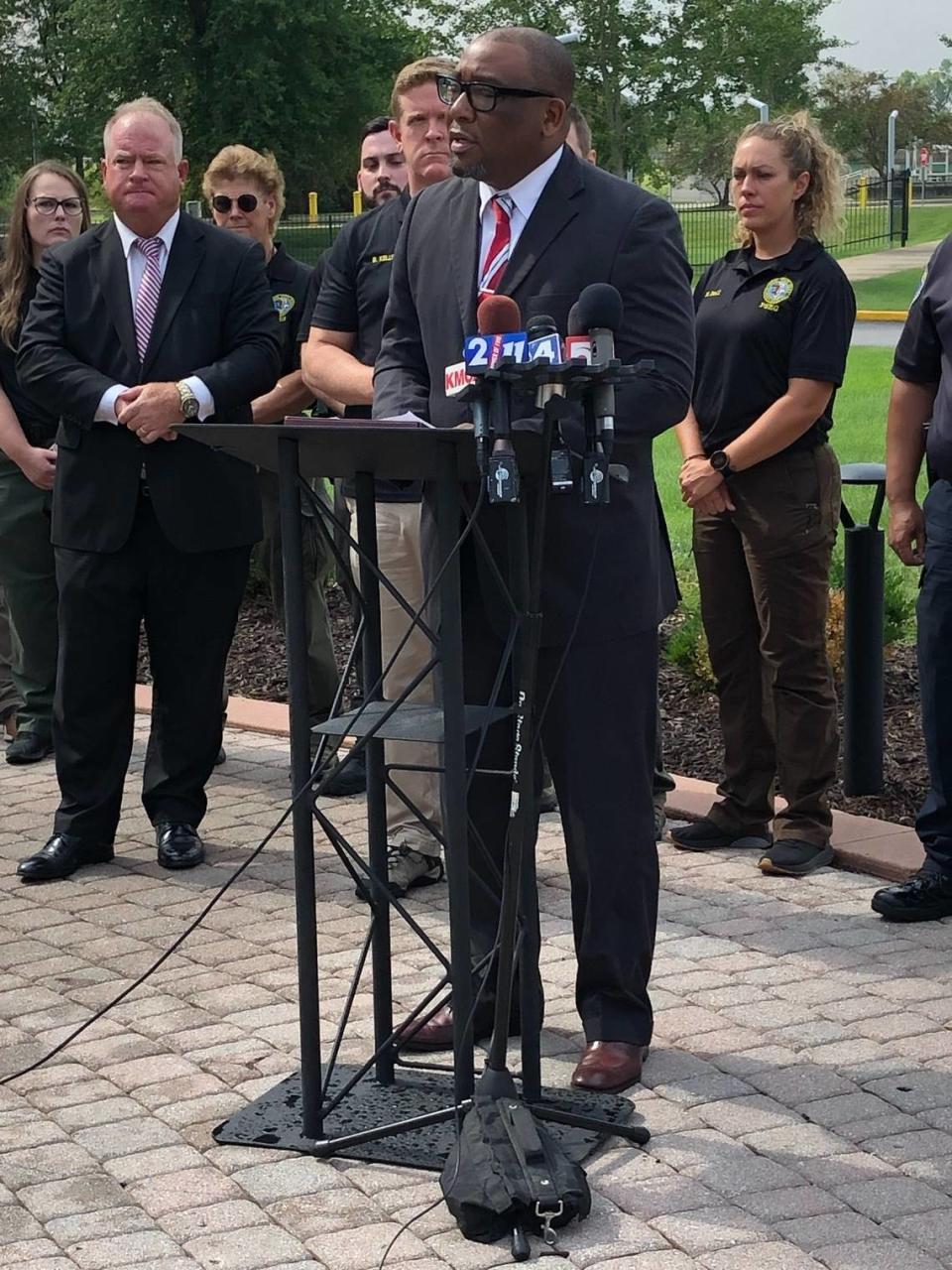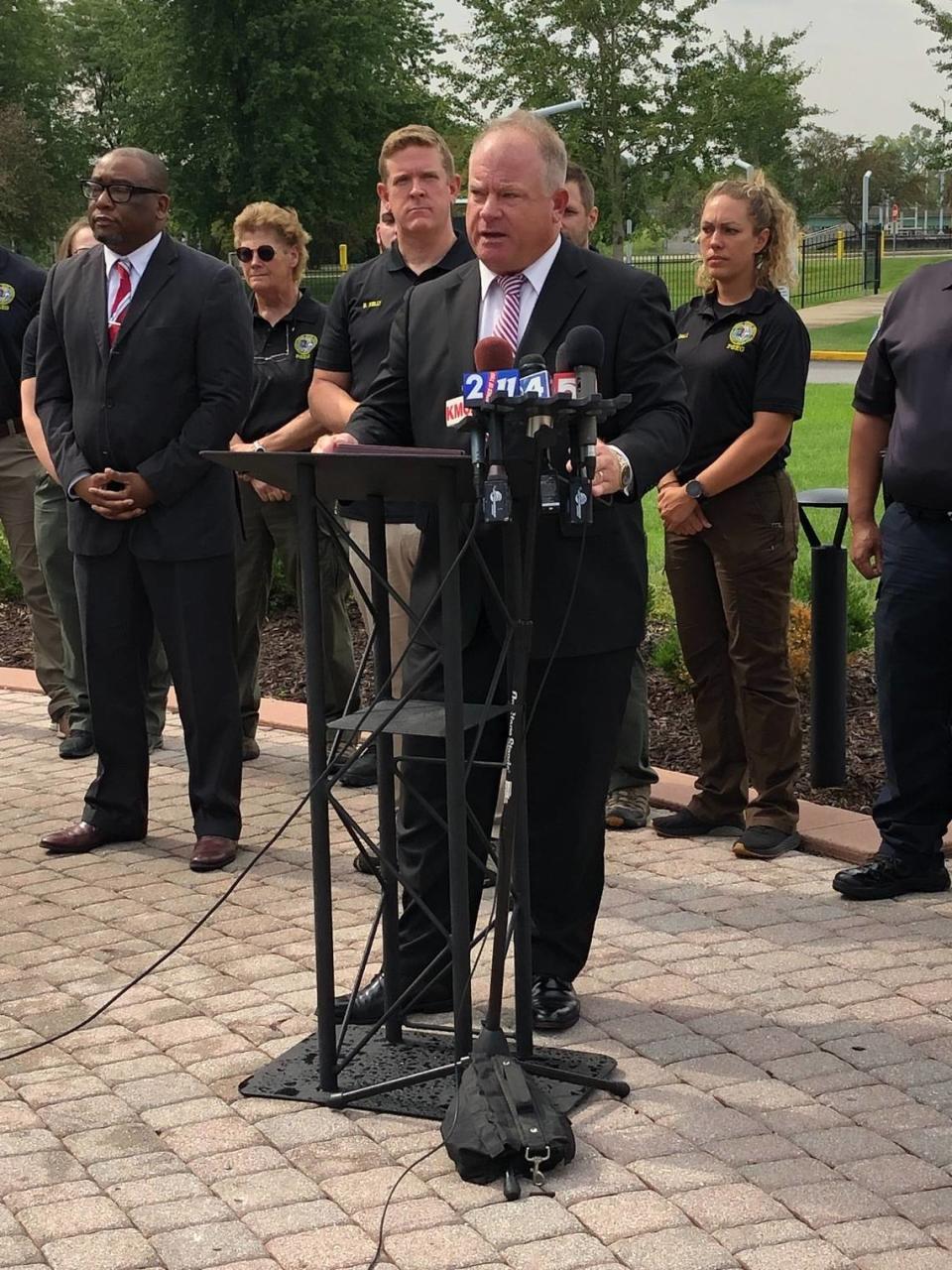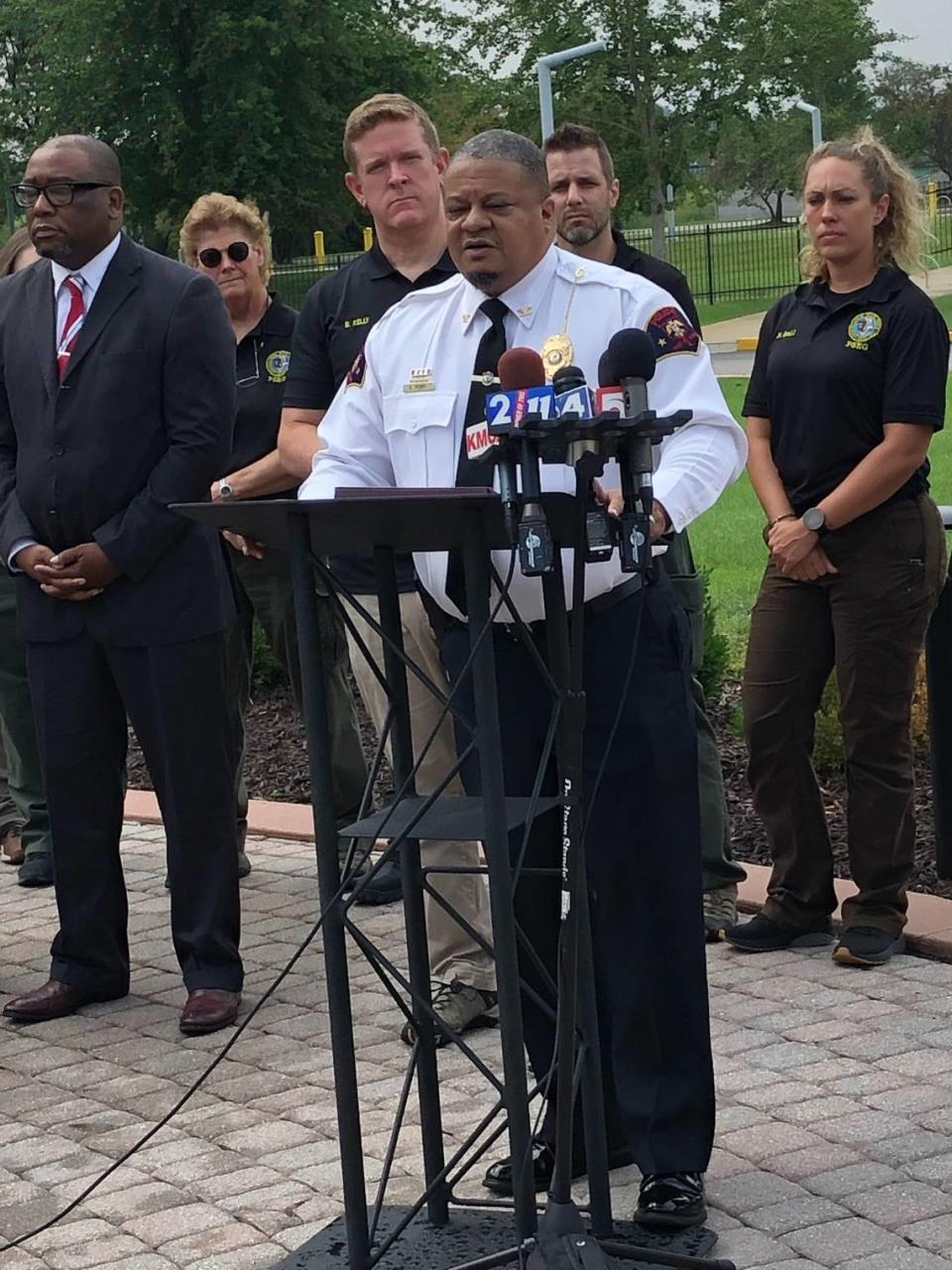Automated license plate readers installed along metro-east interstates as crime fighting tool
Described as a “game-changing” tool in helping fight violent crime, cameras called automated license plate readers are being deployed in the metro-east.
Details about the plan were announced Wednesday morning at a press conference with Illinois State Police Director Brendan Kelly and local officials at the Jackie Joyner-Kersee Center in East St. Louis.
“Jumping onto an interstate is no longer an escape route for criminals,” Kelly said Wednesday morning. “Illinois State Police is using license plate readers to track vehicles suspected of being involved in criminal acts. This technology is helping us catch criminals and solve crime, adding to the resources we’ve already committed to this area. This technology is a game-changer in deterring and solving crimes.”
Forty-five automated license plate readers have already been installed and are in use along Interstate 55, Interstate 70 and Interstate 64. Plans are to install 30 more cameras along metro-east highways before year’s end. State police are working with the Illinois Department of Transportation to install the cameras
“We started here in Madison County and St. Clair due to just the nexus of the Interstate — 64, 70, 55, 255 ... it’s the right location to be able to use these tools,” Kelly noted.
Kelly said authorities will not use the images to catch speeders or for other “petty offenses.”
“This is limited to the most serious offenses,” Kelly said. “This is not for traffic enforcement. This is not a tool used to catch people speeding. That’s not what the technology can be used for. Again, it’s limited and focused to guns, drugs, human trafficking, violent crime ... things that the public absolutely expects law enforcement to be focused on and to be using these very effective tools for.
“It’s focused, it has appropriate protections in terms of privacy and civil liberties, and we want to make sure that those protections are sustained because we want this tool to be around be effective.”

How the technology works
The cameras take still photos of license plates that authorities can use to identify vehicles used during a crime, state police said in an announcement. The agency “uses images from the ALPRs to track the path of a suspect vehicle, which can lead to the apprehension and arrest of suspects,” the release states.
Kelly added the technology is not used to identify persons.
“You might be able to see the person driving,” he said. “But it’s not used primarily to identify persons. It’s not face technology. It’s primarily focused on the license plate. We may see the color of the vehicle. We may be able to kind of make out the make or model of the vehicle and colors or stripes, that sort of thing, that can help to identify the vehicle.
“But it’s not really primarily used to identify a specific person. It is a license plate reader. It is not a face reader.”

Kelly cites examples of technology’s effectiveness
Use of the cameras that already have been installed in the region have been effective, state police said. The agency cited two examples:
Use of the cameras led to the arrest of a suspect in a July 5 shooting death in East St. Louis. Officers from the East St. Louis Police Department and the ISP Public Safety Enforcement Group responded to the shooting. The cameras “were instrumental in identifying the suspect vehicle, which led to the identification of the suspect who has since been charged with First Degree Murder,” state police said.
In another case, a state police trooper used what was referred to as an “ALPR alert” about a vehicle whose owner was wanted for a violent crime in Missouri. “The trooper matched the physical description of the driver with the wanted subject and initiated a stop for a traffic violation,” state police said in a release. “ The driver was arrested on two active warrants out of Missouri for Resisting Arrest and First Degree Assault. Troopers also seized four guns during the course of the stop.”
Cameras strategically deployed in areas with high violent crimes like shooting and carjackings will help make metro-east communities safer, Kelly said. He said his department works with local law enforcement to decide where to post the cameras.

‘Don’t bring your crime here’
Kelly also said ISP’s strategy is not to make the cameras difficult to spot — in fact, just the opposite. Kelly said law enforcement wants the public and criminals to know “these tools are out there.”
“I’m sure anybody with a keen eye can drive around and see them,” he said. “And, frankly, the message here today is not about hiding them. And, particularly, we want anybody that’s thinking about being involved in crime or committing some act of violence to know that we will use these tools, they are out here and we will find you and you will be held accountable for the crimes you’re committing here.
“So don’t come here with your violent activity. Don’t bring your crimes to this community. This tool is there and we’re not hiding it because we want to send that deterrent message: Don’t bring your crime here.”

What others are saying about the cameras
East St. Louis Police Department Chief Kendall Perry lauded the initiative.
“At a time now where crime’s on the highway, crimes committed by vehicles, stolen vehicles are on the rise, this is a key component to deterring a lot of the major crimes in our community,” he said. “This is going to be, as they’ve said, a game-changer for this area.”
St. Clair County State’s Attorney James Gomric echoed Perry’s remarks.
“It is and will be a game-changer,” he said. “Technology has been utilized in law enforcement from the magnifying glass to fingerprints ... all of the changes that we’ve seen during the years that have gone by, license plate readers will be of tremendous benefit as myself and the folks behind me do the good work that needs to be done.”
State Senator Christopher Belt (D-Swansea) called the technology a “crime deterrent.”
“Today, is really a monumental day in the metro-east, it’s a monumental day in Illinois ... because, again, we’re here to talk about a game-changer when it comes to combating crime in the metro-east,” he said. “These devices provide rapid and accurate identification of suspects while allowing law enforcement to take immediate action. By knowing what their movements are and that their movements are being monitored closely by these automated systems criminals may deter from engaging in elicit activities on expressways.”

Additional uses of cameras
Kelly discussed other ways law enforcement can use the technology, including for tracking down potential witnesses.
“It’s also to be able to identify potential witnesses that have been in the area so we can contact them,” he said. “And say ‘We see that you were in close proximity to this particular shooting at a certain time. Did you see anything?’ People sometimes see things, particularly on the interstates and they’re not even sure what it is that they saw, they go about on their lives, they drive on the interstate and may be another state away. But we can use this technology to identify them, reach out to them to see what kind of information we can get.”
Kelly added the cameras can be used in AMBER alerts.
“In addition, if someone is the subject of an AMBER alert — a missing child, maybe a child has been kidnapped and we have an identification of the vehicle, that license plate number can be put into the system. And when we get a hit off of that our officers can be immediately notified,” he said.
The cameras have been in used in Chicago for some time and have been an important tool to help reduce expressway crime, state police said. Expressway shootings in the region dropped by 47% between 2022 and 2021 as a result, according to state police.
More about cameras
The state began installing cameras in the Chicago area with the enactment of the Tamara Clayton Expressway Camera Act in 2020. Clayton was shot to death in February 2019 as she traveled to work on Interstate 57.
Originally, Illinois State Police received $12.5 million from the IDOT Road Fund Grant to purchase specialized cameras, as well as cover the costs of engineering, permitting, and labor associated with installation, controllers, servers/software, electrical power, and communications equipment required to install ALPR systems, according to an agency release.
Due to the program’s success in the Chicago area, on June 6, 2022, Gov. J. B. Pritzker signed an extension of the Tamara Clayton Act, allowing cameras to be installed in 21 more counties in Illinois, including in the metro-east. An additional $20 million has been appropriated to implement this expansion, called Tamara Clayton 2.0.
“At the end of the day this is a tool that is being used by the special agents and the other men and women serving the law enforcement that are standing behind me to be able to bring justice and safety to this area and to this community,” Kelly concluded.
Read full news release: https://t.co/8mhn1L1NDC pic.twitter.com/6vLLXG5wsz— IllinoisStatePolice (@ILStatePolice) July 26, 2023

